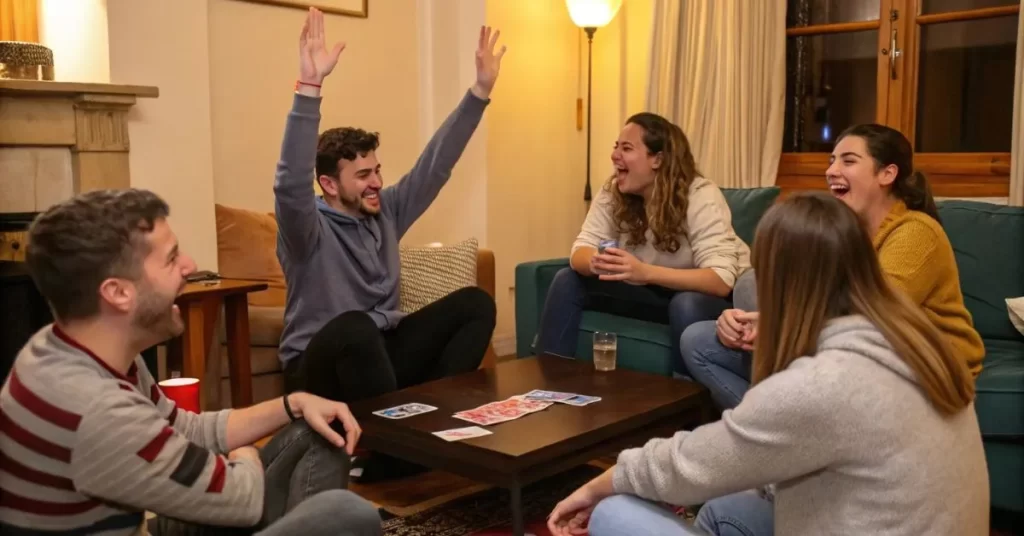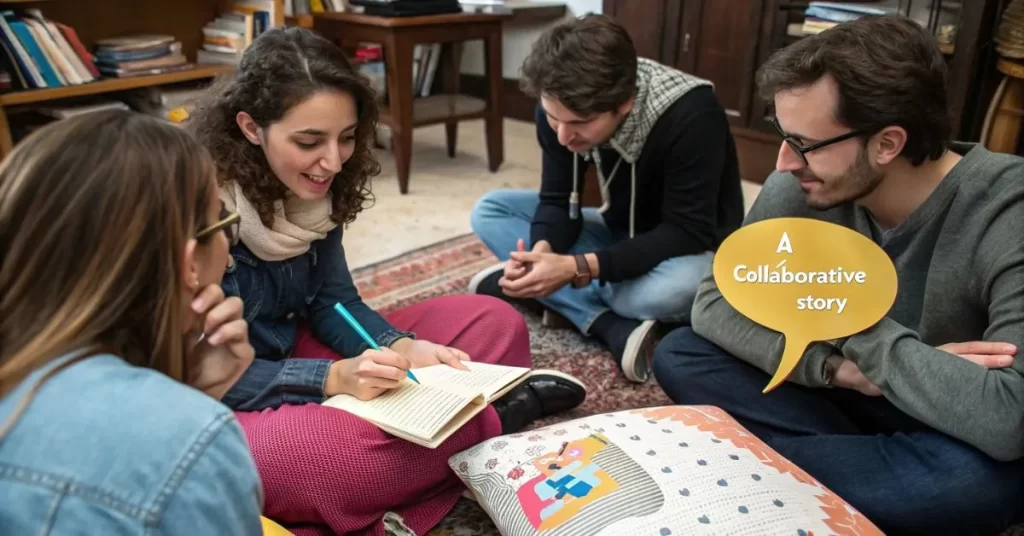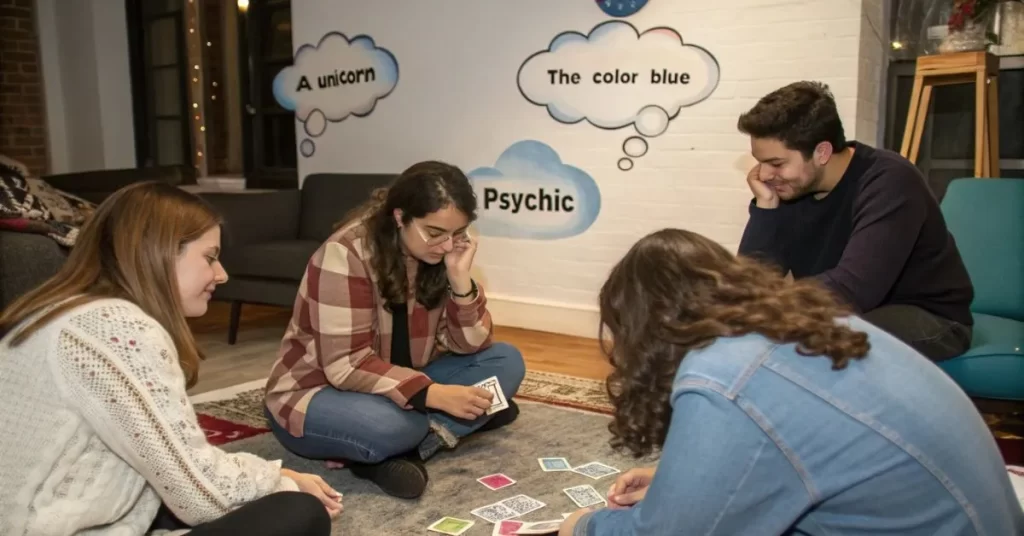In a world where technology and gadgets often dominate our entertainment choices, Games to Play with Friends Without Anything offer a refreshing alternative. Whether you’re stuck indoors on a rainy day or just looking for a fun way to pass the time, countless games can be enjoyed with friends without the need for any equipment or tools.
These games aren’t just about passing time—they’re about sparking creativity, fostering connection, and having a good laugh together. By relying on only our minds and interactions, we discover the beauty of simple fun, where the real value lies in the moments shared, the stories told, and the bonds strengthened. Ready to dive into a world of laughter and teamwork?
Let’s explore the 8 best games to play with friends without anything
1. 20 Questions
Description
20 Questions is a classic guessing game where one player thinks of an object, person, or place, and the rest of the group asks yes-or-no questions to figure out what it is. The twist? The guessing players only have 20 questions to uncover the mystery. The game ends once someone guesses correctly—or all 20 questions are exhausted. The roles rotate, and a new player thinks of something for the others to guess.

The beauty of the game lies in its simplicity. You can play it anywhere—on a road trip, at a party, or even during a casual hangout—and all you need is a willing group and a bit of imagination. The key challenge is to ask the right questions to narrow down the possibilities without wasting valuable questions.
Why It’s Fun
20 Questions is more than just a game of deduction—it’s a game of creativity and strategy. As players ask their yes-or-no questions, they’re not just trying to guess the object—they’re actively shaping the narrative with each question, honing their thinking to get closer to the answer. The game sharpens critical thinking as you weigh the importance of each question, knowing the clock (or rather, the questions) is ticking.
What makes it especially fun is the unpredictability. With endless possibilities of what someone could think of, no two rounds are ever the same. It’s a game that challenges your creativity, sharpens your reasoning, and leads to hilarious moments when the answer is finally revealed. Whether you’re narrowing down a pet animal or figuring out a far-off landmark, the thrill is in the guessing, the thinking, and the fun surprises along the way.
2. Charades
Description
Charades is a lively and interactive game where players take turns acting out a word or phrase while the rest of the group tries to guess what it is. The twist? You can’t use any words or sounds—only gestures and body language are allowed.
To play, start by dividing into two teams or simply take turns individually. Write down a list of words or phrases (or pick them spontaneously), and one player acts out the word or phrase assigned to them within a set time limit, such as one or two minutes. Popular themes include movies, books, TV shows, songs, and even everyday activities. For example, you might act out “rowing a boat” or mimic the motions of a famous superhero.
The game is flexible, too. You can keep score by tracking how many correct guesses each team makes, or play casually without worrying about points—just enjoy the fun of acting and guessing!

Why It’s Fun
Charades is a game that guarantees laughter and fun. Watching someone flail their arms to mimic a flying bird or struggle to convey “Titanic” with dramatic gestures is pure entertainment. The humor arises from the often exaggerated or misunderstood actions, and the pressure of the ticking clock adds a layer of excitement.
Beyond the hilarity, charades foster teamwork and quick thinking as players collaborate to decipher gestures and shout out their guesses. It’s a game that breaks the ice, encourages creativity, and ensures everyone is engaged. Whether you’re showcasing Oscar-worthy acting skills or completely failing most amusingly, charades always deliver unforgettable moments!
3. Two Truths and a Lie
Description
Two Truths and a Lie is a simple and engaging game where each player takes turns sharing three statements about themselves—two of which are true and one that’s a lie. The goal for the other players is to guess which statement is the lie.
To play, everyone sits in a circle or takes turns individually. A player shares their three statements in any order, trying to make the lie as believable as possible to trick the others. For example:
- “I’ve been skydiving.”
- “I hate chocolate.”
- “I can speak three languages.”
The other players discuss and vote on which statement they think is a lie. After everyone has guessed, the player reveals the truth and the lie, often leading to laughter or surprised reactions.

Why It’s Fun
Two Truths and a Lie is not just a guessing game—it’s a fantastic way to learn interesting, quirky, or unexpected facts about your friends. The game naturally sparks curiosity and conversation, as players often follow up with, “Wait, you did that? Tell us more!”
It’s a perfect icebreaker that encourages creativity in crafting statements and helps deepen connections by uncovering unique stories or hidden traits. Whether you’re among close friends or meeting new people, this game guarantees a mix of intrigue, fun revelations, and a lot of laughs.
4. Never Have I Ever
Description
Never Have I Ever is a fun and revealing game where players take turns sharing statements about things they’ve never done. For example, a player might say, “Never have I ever gone skydiving.” If anyone in the group has done it, they share a story about their experience—or in some versions, they can earn or lose a point.
To play, everyone sits in a circle, and one person starts with their statement. The game can be played casually as a way to spark conversations, or you can make it more competitive by keeping track of points. For example, each person starts with ten points, and they lose a point for every statement that applies to them. The last person with points left wins!

Why It’s Fun
Never Have I Ever is all about uncovering surprises and sharing funny or intriguing stories. It’s an excellent icebreaker, as it encourages people to open up and share parts of their lives they might not otherwise reveal.
The game often leads to laughter and gasps as players discover surprising things about each other. Whether it’s a wild travel adventure, an embarrassing childhood moment, or an unusual hobby, the stories that come out of this game create lasting memories and deepen connections. It’s the perfect mix of humor, discovery, and bonding!
5. The Alphabet Game
Description
The Alphabet Game is a quick and engaging game that tests players’ knowledge and creativity. To play, choose a category—like animals, countries, or movies—and take turns naming items in that category in alphabetical order. For example, if the category is animals, the first player might say “Alligator,” the second player “Bear,” and so on, progressing through the alphabet.
If someone can’t think of a word within a set time limit, they’re out for that round. The game can be played casually for fun or with a competitive twist by keeping the score based on how many correct entries each player contributes.

Why It’s Fun
The Alphabet Game combines the thrill of competition with a chance to showcase your knowledge. It’s exciting to think quickly under pressure while coming up with unique answers to stump your friends. The game often leads to hilarious moments when players invent creative or questionable entries in a bid to stay in the game.
It’s a perfect blend of learning and fun, encouraging players to think critically while challenging their memory and vocabulary. Whether you’re trying to outwit your friends or simply enjoying the laughter that comes with a missed or unexpected answer, The Alphabet Game keeps everyone on their toes!
6. Storytelling Round
Description: In the Storytelling Round, players collaborate to create a unique and unpredictable story, one sentence at a time. Each player contributes a sentence that builds on the previous one, leading to a surprising and often hilarious narrative. The story can go in any direction, depending on the creativity of the participants.

Why It’s Fun: This round highlights the creativity and unpredictability of shared storytelling. As each player adds to the tale, the story takes unexpected twists, often leading to funny or absurd situations. The collaborative nature fosters imagination and teamwork, while the ever-evolving plot keeps everyone engaged. Whether the story turns into an epic adventure or a whimsical comedy, the Storytelling Round always delivers laughter and excitement!
7. Would You Rather
Description: In Would You Rather, players take turns presenting two challenging or humorous scenarios, and others must choose which one they’d prefer. The questions can range from lighthearted and silly to thought-provoking or outlandish. For example, “Would you rather be able to fly or read minds?” Each player has to pick one option, often leading to interesting debates or laughs.

Why It’s Fun: This game sparks engaging conversations, as players explain their choices and debate the merits of each scenario. It reveals preferences, quirks, and sometimes hidden desires in a light-hearted way. The unpredictable nature of the questions and the opportunity to dive into each other’s minds makes Would You Rather a fun way to bond and share laughs. It’s also a fantastic icebreaker for new groups of friends!
8. Psychic
Description: In Psychic, one player secretly thinks of a word, object, or scenario, and the other players take turns guessing what it is by asking yes-or-no questions. The player with the secret answer must respond with “yes,” “no,” or “I don’t know.” The goal is to guess the correct answer in as few questions as possible. The twist is that players often try to tap into their “psychic” intuition, attempting to guess the answer based on vague clues or a hunch.

Why It’s Fun: Psychic taps into the power of intuition, making it a suspenseful and often hilarious game. As players take wild guesses or ask quirky questions, the game leads to surprising or humorous outcomes. The thrill of trying to “read” someone’s mind adds a unique element of fun, and the unpredictable nature keeps everyone on their toes. Whether the guess is wildly off the mark or eerily close, Psychic guarantees laughter and a memorable experience.
Conclusion
In this collection of games, we’ve seen how simple, no-material games can create lasting memories and deep connections. From the creative challenge of storytelling to the competitive spark of the Alphabet Game, each game fosters creativity, teamwork, and plenty of laughter. These games are not only fun, but they also encourage players to think critically, bond on a deeper level, and share unforgettable moments.
So gather your friends, dive into these games, and enjoy the joy of spending quality time without the need for anything more than your imagination!
Encouragement
Now it’s your turn to give these games a shot! Whether it’s breaking the ice, sparking laughter, or fueling friendly debates, these games are sure to bring you closer to your friends and leave you with lasting memories.
Call to Action
Have a favorite game you love to play without any equipment? We’d love to hear about it! Share your go-to games and experiences in the comments below and inspire others to join in the fun. Let the good times roll!
Pro Tips for Maximizing Fun
- Set Themes: Spice up games like Charades or 20 Questions by choosing fun themes, such as movies, superheroes, or holiday traditions.
- Add Playful Rules: Introduce quirky rules like a time limit for answers, silly penalties for incorrect guesses, or bonus points for extra creativity.
- Keep Score: For competitive games like The Alphabet Game or Would You Rather, keeping score can add an exciting edge. You can even reward the winner with a fun title like “Game Night Champion!”
Related Suggestions
Looking for more minimalist fun? Try these activities:
- Improv Scenes: Take turns acting out silly, made-up scenarios with no script.
- Memory Chain: Build a memory chain where each player repeats the previous items and adds their own—perfect for testing your recall.
- Outdoor Variations: Adapt these games for a walk in the park or a picnic—like nature-inspired 20 Questions or Alphabet Game with things you spot around you.
No matter how you tweak the games or where you play them, the key ingredient is always the same: the joy of being together and having fun!
Frequently Asked Questions: games to play with friends without anything
How many players do I need for these games?
Most games can be played with 2-10 players, though some work better with larger groups:
20 Questions: 2+ players
Charades: Best with 4+ players for team formation
Two Truths and a Lie: 3+ players for better guessing dynamics
Never Have I Ever: 4+ players for more diverse experiences
The Alphabet Game: 2+ players
Storytelling Round: 3+ players for varied narrative contributions
Would You Rather: 2+ players
Psychic: 2+ players
Q: Can these games be played virtually?
Yes! Most of these games adapt well to virtual settings through video calls. Charades might require a wider camera view for full-body gestures, but all other games can be played exactly as they would in person.
Q: How long does each game typically last?
20 Questions: 10-15 minutes per round
Charades: 15-30 minutes for a full session
Two Truths and a Lie: 5-10 minutes per person
Never Have I Ever: 20-30 minutes
The Alphabet Game: 10-15 minutes per category
Storytelling Round: 15-20 minutes per story
Would You Rather: Flexible, typically 15-30 minutes
Psychic: 10-15 minutes per round
Q: Are these games suitable for all age groups?
Yes! All games can be adapted for different age groups by adjusting:
Difficulty level of questions/topics
Complexity of words or phrases
Category choices
Time limits
Rule modifications
Q: How can I make these games more challenging?
Several options are available:
Add time limits for responses
Implement point systems
Create themed rounds
Add additional rules or restrictions
Combine elements from different games
Include penalties for wrong answers
Q: What if someone gets stuck or can’t think of anything?
The article suggests several solutions:
Allow a reasonable time for thinking
Offer category suggestions
Provide hints when needed
Skip to the next person if necessary
Keep the atmosphere light and supportive
Q: How do you keep score in these games?
Scoring methods vary by game:
Traditional point system (1 point per correct answer)
Countdown system (starting with 10 points, losing points for incorrect answers)
Team-based scoring
Time-based scoring (faster answers earn more points)
No scoring for casual play
What makes these games effective as icebreakers?
These games excel as icebreakers because they:
Require no special equipment or preparation
Encourage personal sharing in a structured way
Create natural conversation opportunities
Generate shared laughter and experiences
Allow for varying levels of participation comfort
Q: How can these games be modified for different settings?
Games can be adapted for various settings by:
Adjusting themes for professional vs. casual environments
Modifying time limits based on the situation
Creating special rules for specific locations or occasions
Incorporating elements from the surrounding environment
Combining games for longer entertainment sessions
Q: What are some common mistakes to avoid?
Key points to remember:
Don’t rush players who need time to think
Avoid making the games too competitive
Don’t force participation from uncomfortable players
Keep appropriate content for the audience
Maintain clear rules and fair play
Don’t let any single player dominate the game
Q: How can I ensure everyone has fun?
The article suggests several strategies:
Rotate starting players regularly
Mix up teams or partnerships
Keep the pace moving
Encourage creativity and humor
Maintain a supportive atmosphere
Celebrate participation over winning
What makes these games particularly engaging?
These games are engaging because they:
Foster creativity and imagination
Create opportunities for personal expression
Generate shared experiences
Encourage active participation
Adapt to different group dynamics
Require no special equipment or preparation






